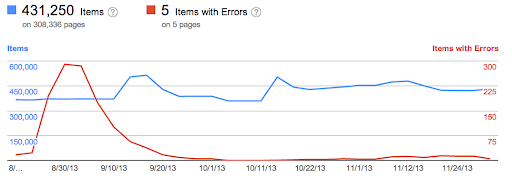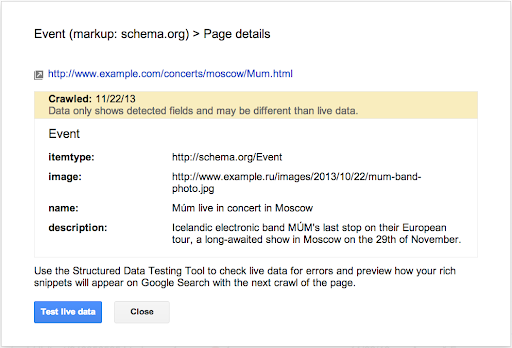Thursday, December 12, 2013
Since we launched the Structured Data dashboard last year, it has quickly become one of the most popular features in Webmaster Tools. We've been working to expand it and make it even easier to debug issues so that you can see how Google understands the marked-up content on your site.
Starting today, you can see items with errors in the Structured Data dashboard. This new feature is a result of a collaboration with webmasters, whom we invited in June to>register as early testers of markup error reporting in Webmaster Tools. We've incorporated their feedback to improve the functionality of the Structured Data dashboard.
An "item" here represents one top-level structured data element (nested items are not counted) tagged in the HTML code. They are grouped by data type and ordered by number of errors:

We've added a separate scale for the errors on the right side of the graph in the dashboard, so you can compare items and errors over time. This can be useful to spot connections between changes you may have made on your site and markup errors that are appearing (or disappearing!).
Our data pipelines have also been updated for more comprehensive reporting, so you may initially see fewer data points in the chronological graph.
How to debug markup implementation errors
- To investigate an issue with a specific content type, click on it and we'll show you the markup errors we've found for that type. You can see all of them at once, or filter by error type using the tabs at the top:
-
Check to see if the markup meets the
implementation guidelines for each content type.
In our example case (events markup), some of the items are missing a
startDateornameproperty. We also surface missing properties for nested content types (for example, a review item inside a product item)—in this case, this is thelowpriceproperty. - Click on URLs in the table to see details about what markup we've detected when we crawled the page last and what's missing. You'll can also use the "Test live data" button to test your markup in the Structured Data Testing Tool. Often when checking a bunch of URLs, you're likely to spot a common issue that you can solve with a single change (for example, by adjusting a setting or template in your content management system).
- Fix the issues and test the new implementation in the Structured Data Testing Tool. After the pages are recrawled and reprocessed, the changes will be reflected in the Structured Data dashboard.


We hope this new feature helps you manage the structured data markup on your site better. We will continue to add more error types in the coming months. Meanwhile, we look forward to your comments and questions here or in the dedicated Structured Data section of the Webmaster Help forum.
